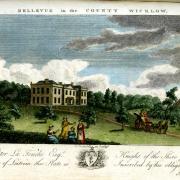The Natural Sciences in Print: Botany, Agriculture and Horticulture
Published on 8th November 2012
 The natural sciences formed an important branch of science from the earliest times. Growing plants and crops to feed the population and for healing the sick were essential pursuits. Development of new crops or improving the yields of existing crops resulted from experimentation and the publication of research results. Botanical knowledge was passed on to future generations in manuscript and printed form, study of these documents allows us to view the progress of knowledge over the centuries, and to recreate the planted landscape of past societies.
The natural sciences formed an important branch of science from the earliest times. Growing plants and crops to feed the population and for healing the sick were essential pursuits. Development of new crops or improving the yields of existing crops resulted from experimentation and the publication of research results. Botanical knowledge was passed on to future generations in manuscript and printed form, study of these documents allows us to view the progress of knowledge over the centuries, and to recreate the planted landscape of past societies.
Medicine was the driving force in the development of botany. Physic gardens and botanic gardens were created to train students to identify plants and their properties. Gardens attached to monasteries provided herbs for healing and practical knowledge was passed on orally or in written versions. Families of hereditary physicians flourished in medieval Ireland, patronized by the Gaelic Irish chiefs. Knowledge of healing plants was essential to their craft, and manuscript herbals were produced to transmit medical knowledge. Country lore relating to healing plants was passed on orally from one individual to another, often women. The earliest printed books and treatises were in Latin, aimed at medical practitioners. By the 16th century books began to appear in vernacular languages, and while still aimed at professionals, were accessible to the literate amateur. Illustrations and botanical drawings helped the reader to identify different plants and their parts. These often took the form of crude woodcuts, but increasingly fine engraving was needed to show the intricate differences between examples.
The 17th century saw an increased availability of texts such as herbals and treatises on forest trees. By the 18th century books and prints were aimed at the farmer or gardener. Works on agriculture and the management of trees were published, and societies such as the Dublin Society (later the Royal Dublin Society - RDS) gave premiums, or awards, for land improvements and for growing vegetables and fruit. Landowners also sought to improve their estates by the development of extensive gardens to provide fresh fruit and vegetables but also as cultivated spaces for the entertainment of guests. Italy and France led the way in garden design up the 18th century and many books were translated into English, or imported from Europe in their original languages.
In Ireland books on the natural sciences with finely engraved plates were mainly imported before the 18th century. These imported texts were expensive, so their availability was limited to the wealthy. In the 18th and 19th centuries practical manuals were published in simplified form and sold as chapbooks: small, affordable texts aimed at the smallholder to help him grow crops to feed a family.
In the 18th and 19th centuries attempts were made to classify Irish plants and to produce a Flora Hibernica: a list of native plants for each region in the country. Individual projects were begun and contributions were published for different counties. Dr John Rutty published An essay towards a natural history of the county of Dublin in 1772. Dr Walter Wade, a botanist working in Dublin, advertised proposals for the publication of a flora of Dublin in the 1780s, but this major project was not completed. He did, however, publish many other botanical works. A series of statistical surveys relating to different Irish counties was commissioned by the Dublin Society in the early years of the 19th century, in which agricultural advances formed an important element of each survey. View the catalogue details for statistical surveys.
This gallery contains images from a variety of texts which were available to Irish readers from the 17th century to the early 20th century. All images are taken from the collections of Dublin City Libraries. The material can be viewed in the Reading Room, Dublin City Library and Archive, Pearse Street, which holds a wealth of material on the history of Dublin, including books, pamphlets, journals, street directories, and almanacs.
Further Resources
Dublin City Libraries has a wide range of sources on the social, political, and cultural history of Dublin, some of which are available online and some through the Dublin City Libraries network.
The Reading Room, Dublin City Library and Archive, Pearse Street holds a wealth of material on the history of Dublin, including books, pamphlets, journals, street directories, and almanacs.
The following online resources can be accessed free of charge at your local library. Ask library staff for information and assistance.
- DRI - Digital Repository of Ireland is a national digital repository for Ireland’s humanities, social sciences, and cultural heritage data. Here you will find select digital collections of Dublin City Library and Archive. Highlights of the collection include the Fáilte Ireland Photographic Collection, the Jacobs Biscuit Factory Photographic Archive, Wide Street Commission and the Royal Dublin Fusiliers Association Archive.
- Irish Times Digital Archive: This online archive service gives access to contemporary editions of the Irish Times from the mid-nineteenth century until the present.
- Irish Newspaper Archive: This online archive service gives access to contemporary editions of the Irish Independent and a range of other newspapers.
- The Ireland-JSTOR Collection: This online archive of academic articles can also be accessed free of charge at your local library.
For further reading, consult the Library Catalogue.